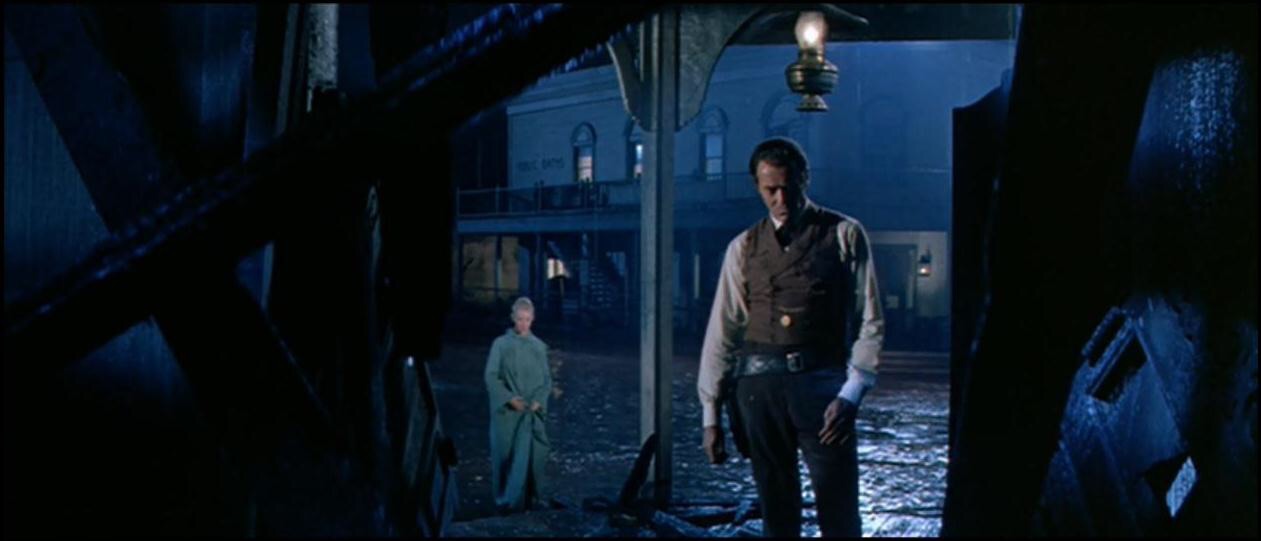all he knows is killing
In the 1880s, it was apparently an insult to call a cattleman a "cowboy" (at least around Tombstone). (To be fair, the titular town of Warlock is in Utah, a good distance from Tombstone.) This may have been because of the Cochise County Cowboys (Johnny Ringo, Ike Clanton and their ilk), or they may have been called cowboys because the term was in disfavor. The negative take on cowboy did get outside of Arizona; the San Francisco Examiner, as quoted in The Earp-Holliday Trial: An Account, said in 1881, "Cowboys [are] the most reckless class of outlaws in that wild country... infinitely worse than the ordinary robber" (Linder, 2005).
I mention this because the people of Warlock refer to the outlaws who occasionally come into town to make trouble the San Pablo Cowboys. In terms of Wright's (1975) oppositions--Wright does not mention Warlock specifically--this suggests a clear division between the townspeople and the cowboys. If these were legitimate cowboys, i.e. cattlemen, the opposition would not be so overt.
Unlike Rio Bravo, this film includes a good amount of extras--townsfolk standing around here and there when things get interesting. Society is not left on the sidelines of the film, though they are pretty much on the sidelines of the conflict. As the professional plot revolves around two groups of men fighting against each other, society is usually just a mere backdrop.
The plot here resembles the setup in Tombstone; hired Marshall Clay Blaisedell (Henry Fonda), like Wyatt Earp, is a legendary gunmen brought in to clean up the town; Tom Morgan (Anthony Quinn) is like the Doc Holliday to Blaisdell's Earp, capable of doing the dirty work that the "lawman" cannot; Lily Dollar (Dorothy Malone) is like Kate Fisher, a sometimes prostitute who helped out Earp and Holliday from time to time. The San Pablo Cowboys replace the Cochise County Cowboys and this might as well be an adaptation of the Tombstone story. Except, then there's Johnny Gannon (Richard Widmark). Credited first at the top of the film, Widmark has the more complicated character--a Cowboy who turns into a lawman, a deputy to Sheriff Keller (Hugh Sanders), who criticizes the practices of Blaisedell and Morgan as being just as much outside the law as the Cowboys.
>
Groggy Dundee, in his Nothing is Written: A Film Blog review of Warlock argues that this film functions as "a deconstruction of the Wyatt Earp legend." I'm not sure it deconstructs it so much as it covers it like a singer might cover a classic song. Taking Gunfight at the O.K. Corral at the original (which, of course, it isn't), this is one of those rare covers that surpassed the old version. While most of the Cowboys remain without personality, their leader Abe McQuown (Tom Drake), Gannon's little brother Billy (Frank Gorshin), Curley (DeForest Kelley)--they get some personality, though not nearly as much screentime as Blaisedell or Morgan or Gannon or Lily or Jessie. This is a good ensemble piece, really. And, it builds up to each of its bouts of violence with dialogue, including debate over the use of violence and the justification of the presence of pseudo-lawmen Blaisedell and Morgan. It's not really a deconstruction of the Wyatt Earp story, per se, but it just might be leaning toward some sort of deconstruction of the Western itself. These films always end in violence, and this might be the first to really question whether or not that is okay.
And, the penultimate standoff (Blaisedell and Morgan) is rather tragic and sad, an unusual feeling for a Western.
Comments
Post a Comment